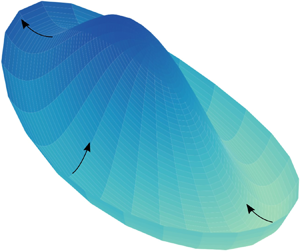Article contents
Instability and symmetry breaking in binary evaporating thin films over a solid spherical dome
Published online by Cambridge University Press: 12 March 2021
Abstract

We examine the axisymmetric and non-axisymmetric flows of thin fluid films over a spherical glass dome. A thin film is formed by raising a submerged dome through a silicone oil mixture composed of a volatile, low surface tension species (1 cSt, solvent) and a non-volatile species at a higher surface tension (5 cSt, initial solute volume fraction  $\phi _0$). Evaporation of the 1 cSt silicone oil establishes a concentration gradient and, thus, a surface tension gradient that drives a Marangoni flow that leads to the formation of an initially axisymmetric mound. Experimentally, when
$\phi _0$). Evaporation of the 1 cSt silicone oil establishes a concentration gradient and, thus, a surface tension gradient that drives a Marangoni flow that leads to the formation of an initially axisymmetric mound. Experimentally, when  $\phi _0 \leqslant 0.3\,\%$, the mound grows axisymmetrically for long times (Rodríguez-Hakim et al., Phys. Rev. Fluids, vol. 4, 2019, pp. 1–22), whereas when
$\phi _0 \leqslant 0.3\,\%$, the mound grows axisymmetrically for long times (Rodríguez-Hakim et al., Phys. Rev. Fluids, vol. 4, 2019, pp. 1–22), whereas when  $\phi _0 \geqslant 0.35\,\%$, the mound discharges in a preferred direction, thereby breaking symmetry. Using lubrication theory and numerical solutions, we demonstrate that, under the right conditions, external disturbances can cause an imbalance between the Marangoni flow and the capillary flow, leading to symmetry breaking. In both experiments and simulations, we observe that (i) the apparent, most amplified disturbance has an azimuthal wavenumber of unity, and (ii) an enhanced Marangoni driving force (larger
$\phi _0 \geqslant 0.35\,\%$, the mound discharges in a preferred direction, thereby breaking symmetry. Using lubrication theory and numerical solutions, we demonstrate that, under the right conditions, external disturbances can cause an imbalance between the Marangoni flow and the capillary flow, leading to symmetry breaking. In both experiments and simulations, we observe that (i) the apparent, most amplified disturbance has an azimuthal wavenumber of unity, and (ii) an enhanced Marangoni driving force (larger  $\phi _0$) leads to an earlier onset of the instability. The linear stability analysis shows that capillarity and diffusion stabilize the system, while Marangoni driving forces contribute to the growth in the disturbances.
$\phi _0$) leads to an earlier onset of the instability. The linear stability analysis shows that capillarity and diffusion stabilize the system, while Marangoni driving forces contribute to the growth in the disturbances.
- Type
- JFM Papers
- Information
- Copyright
- © The Author(s), 2021. Published by Cambridge University Press
References
REFERENCES
- 3
- Cited by





